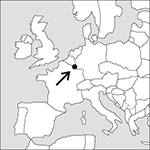
Source: MAPS IN MINUTES™ © RH Publications (1997)
Capital:
Luxembourg
Area:
2586 sq km (999 sq miles)
Population:
514,862 (2013 est)
Currency:
1 euro = 100 cents
Religions:
Roman Catholic 87.0%
Ethnic Groups:
Luxembourger 63.1%; Portuguese 13.3%; French 4.5%; Italian 4.3%
Languages:
Luxembourgish, French, German (all official)
International Organizations:
UN; EU; OECD; NATO; Council of Europe; OSCE; WTO
A small country in north‐west Europe surrounded by Belgium to the west and north, Germany to the east, and France to the south.
Physical
The climate is temperate continental and there are sizeable forests, but the ground is hilly and rocky with little fertile soil.
Economy
Attractive conditions including banking secrecy have made international financial services the dominant industry; these now contribute over a quarter of GDP. Historically steel was the major industry (iron ore being abundant), but such areas as information technology, telecommunications, freight transport, food processing, and chemicals are now also significant. There is a small agricultural sector.
History
Luxembourg was occupied by the Romans, then by the Franks in the 5th century, passing to the counts of Luxembourg in the 11th century. The duchy of Luxembourg was created in 1354. Seized by Burgundy in 1443, it passed to the Habsburgs in 1477 and to Spain in 1555. The French occupied it from 1684 until 1697. The first Count of Luxembourg was Conrad, who took the title in 1060. Luxembourg passed again to the Habsburgs after the War of the Spanish Succession (1701–14). In 1815 it was handed over to the Netherlands but joined the Belgians in the revolt of 1830; in 1831 Luxembourg was divided, the Walloon‐speaking region becoming part of Belgium. The rest of Luxembourg remained within the Netherlands and became the Grand Duchy of Luxembourg in 1839 with its own government. In 1890 the King of the Netherlands died without a male heir and from then on the two countries were headed by different royal families. Grand Duke Jean (1921–2019) succeeded in 1964 when his mother, Grand Duchess Charlotte (1896–1985), abdicated in his favour. Luxembourg entered into an economic union with Belgium in 1921. The Netherlands joined this union in 1948, to form the Benelux Economic Union, which was the first free‐trade area in Europe. Luxembourg was a founder member of the European Economic Community (now the European Union). Grand Duke Jean abdicated in 2000 in favour of his son, Henri (1955– ). Luxembourg adopted the euro as its currency in 2002. Since World War II the centre-right Christian Social People’s Party has been almost continuously in power as the leading partner in various coalitions; the exceptions are 1974–79 and from 2013, when a Democratic Party-led coalition was formed under Xavier Bettel.
- abherent
- abhidharma
- ABI
- ability and earnings
- ability to pay
- ab-initio calculation
- abiogenesis
- abiotic
- abiotic factor
- ablation
- ablation age
- ablation shield
- ablation till
- ablation zone
- ablative
- ablimaton
- ABMA
- abninivesha
- abnormal obsolescence
- abnormal profit
- abnormal termination
- abolitionists
- abolition of slavery
- abomasum
- ABONE